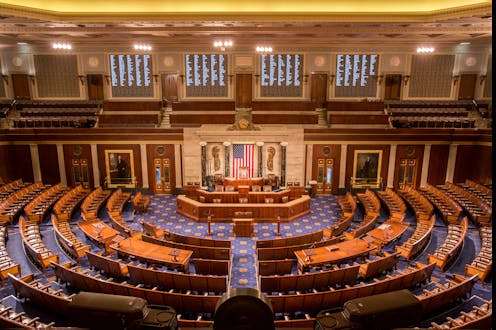Census results shift political power in Congress, presidential elections
- Written by Dudley L. Poston Jr., Professor of Sociology, Texas A&M University

New data from the 2020 U.S. census released April 26, 2021, indicates that starting in 2023 – after the next congressional elections – seven states will have fewer seats in Congress than they do now, and six will have more.
These calculations and changes are the primary purpose of the government’s efforts every 10 years to count all the people who live in the United States. It’s written into the U.S. Constitution[1]. In addition, the number of House seats a state has helps determine the size of its delegation to the Electoral College, increasing or decreasing state residents’ power to pick the president[2].
The seven states that each lost one seat in the House as a result of the 2020 census are California, from 53 to 52; Illinois, from 18 to 17; Michigan, from 14 to 13; New York, from 27 to 26; Ohio, from 16 to 15; Pennsylvania, from 18 to 17; and West Virginia, from 3 to 2.
The six states that gained one or more seats after the 2020 count are Colorado, from 7 to 8; Florida, from 27 to 28; Montana, from 1 to 2; North Carolina, from 13 to 14; Oregon, from 5 to 6; and Texas, which gained two, from 36 to 38.
Who gets counted?
During the census, the U.S. Census Bureau counts the number of people who live in each state on census day of the census year – in this case, April 1, 2020.
The bureau also counts all military and U.S. government employees[3] and their dependents who live overseas on that day – and determines which states they claim as their residences when in the U.S.
Any military personnel who are only temporarily deployed overseas are not counted where they live, but in the states where the military bases from which they were deployed[4] are located.
Those numbers deliver a total number of people who live in each state, for apportionment purposes.
Doing the calculations
When determining how many seats a state gets, there are a few constraints.
First is that there are 435 seats and 50 states; the District of Columbia participates in the Electoral College, but gets only a nonvoting delegate in Congress[5].
In addition, states cannot get partial seats[6]. Because every state must get at least one seat, the first 50 seats are assigned automatically, one per state.
The Constitution does not specify the specific method of apportioning the rest of the congressional seats, but the underlying assumption is best summarized as “one person, one vote[7]” – every person residing in every state should be included, and no person should have more of a voice than any other.
After the first 50, the 385 remaining seats are assigned according to a system called the Method of Equal Proportions[8], first proposed in 1911 by a U.S. Census Bureau statistician named Joseph A. Hill. This method was first used in the apportionment based on the 1940 census, and has been used ever since. It is a statistical and mathematical series of calculations[9] that determines the priority order in which states receive second seats, third seats and additional seats beyond that[10].
In states that have more than one congressional district, additional calculations will be necessary to determine the boundaries of each of those districts. Often that process is left up to state legislators[11]. The data needed for that next step will be available by Sept. 30, Commerce Secretary Gina Raimondo said during a virtual press conference[12] announcing the apportionment results.
[Understand what’s going on in Washington. Sign up for The Conversation’s Politics Weekly[13].]
References
- ^ written into the U.S. Constitution (constitution.congress.gov)
- ^ state residents’ power to pick the president (theconversation.com)
- ^ all military and U.S. government employees (www.census.gov)
- ^ states where the military bases from which they were deployed (www.marketwatch.com)
- ^ nonvoting delegate in Congress (www.wusa9.com)
- ^ states cannot get partial seats (doi.org)
- ^ one person, one vote (theconversation.com)
- ^ Method of Equal Proportions (doi.org)
- ^ statistical and mathematical series of calculations (www.census.gov)
- ^ additional seats beyond that (www.cambridge.org)
- ^ left up to state legislators (theconversation.com)
- ^ virtual press conference (www.census.gov)
- ^ Sign up for The Conversation’s Politics Weekly (theconversation.com)
Authors: Dudley L. Poston Jr., Professor of Sociology, Texas A&M University

